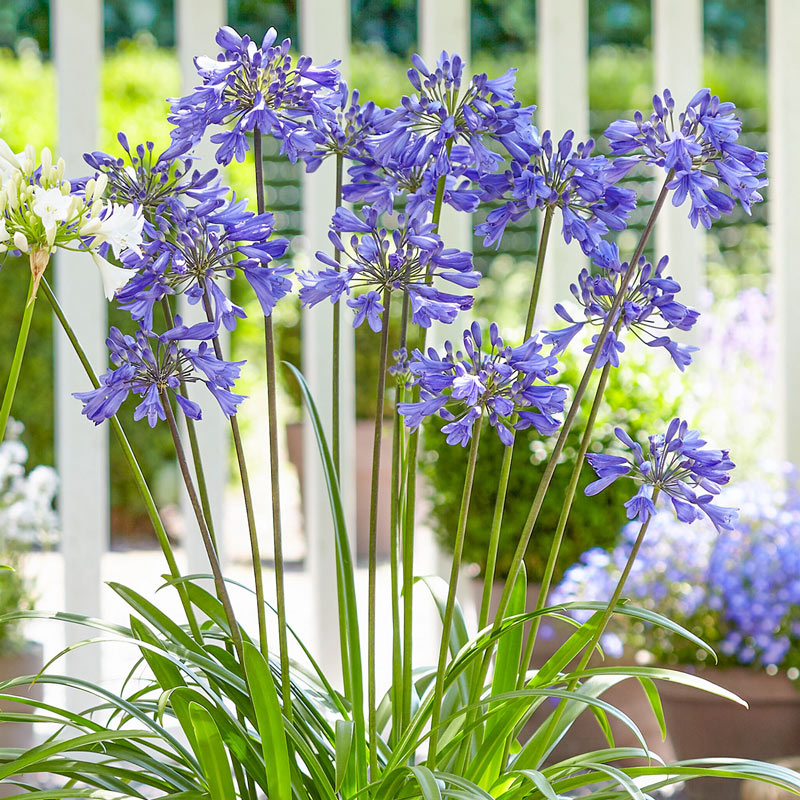Agapanthus Expanding Problems: Soil, Sunshine, and Watering
Agapanthus Expanding Problems: Soil, Sunshine, and Watering
Blog Article
Understanding the Art of Agapanthus Treatment: Important Steps for Healthy Growth and Vibrant Blooms
In the world of horticulture, the cultivation of agapanthus stands as a rewarding venture for those that seek to support these sophisticated flowering plants. With their striking blooms and elegant foliage, agapanthus has actually recorded the interest of garden enthusiasts worldwide. Nevertheless, achieving optimum growth and vibrant blossoms needs a nuanced method that encompasses different crucial actions. From selecting the appropriate range to understanding trimming methods, the trip in the direction of cultivating growing agapanthus plants is multifaceted and holds the key to opening the full potential of these botanical gems.

Choosing the Right Agapanthus Range

When selecting the ideal Agapanthus selection for your yard, consider elements such as climate viability, blossom color, and growth routine. Agapanthus, typically referred to as Lily of the Nile or African lily, is available in a range of colors ranging from shades of purple and blue to white. Pick a bloom color that matches your existing garden palette to produce a harmonious landscape. In addition, take into consideration the climate in your region to ensure the Agapanthus selection you pick can grow in your particular problems. Some selections are more tolerant of cool temperature levels, while others like warmer climates. Comprehending the development routine of different Agapanthus ranges is vital for correct positioning within your yard. Some varieties have a clumping development behavior, ideal for boundaries or containers, while others have a more dispersing nature, appropriate for ground cover or mass growings. By carefully reviewing these aspects, you can choose the best Agapanthus selection to enhance the elegance of your garden.
Perfect Growing Conditions
Thinking about the optimal environmental requirements is vital for effective Agapanthus cultivation. Agapanthus plants are sensitive to cold temperatures and must be protected from frost during winter season months.
To make certain healthy and balanced growth and dynamic flowers, plant Agapanthus light bulbs at a deepness of about 2-4 inches and area them 8-12 inches apart. Mulching around the base of the plants helps preserve moisture and subdues weed growth.
Watering and Feeding Tips
Keeping correct dampness degrees and giving crucial nutrients are vital aspects in the care regimen for Agapanthus plants. When it involves watering Agapanthus, it is crucial to strike an equilibrium. If overwatered, these plants choose regularly moist dirt however are susceptible to root rot. Throughout the growing season, water deeply as Visit Website soon as a week, making certain the soil is well-draining to prevent waterlogging. In hotter climates or throughout durations of drought, more frequent watering might be needed to keep the soil equally wet. check my source Nonetheless, reduce watering in the winter months to stop waterlogged problems.
Fertilizing Agapanthus is necessary for promoting healthy and balanced development and respected blooms. Use a well balanced plant food, such as a 10-10-10 formula, in the very early springtime as new development arises. By following these watering and fertilizing tips, you can ensure your Agapanthus plants prosper and generate lively, durable blooms.
Pruning Methods for Agapanthus
Pruning Agapanthus plants at the proper times and with appropriate methods is essential for maintaining their health and advertising optimum development and flowering. The excellent time to trim Agapanthus is in late winter or early spring before new growth arises.
Deadheading spent blossoms can additionally redirect the plant's power into generating more flowers rather than setting seeds. If you desire to collect seeds for proliferation, leave some flowers to fully grown and completely dry on the plant.
Keep in mind to use tidy, sharp devices to make accurate cuts and reduce the threat of introducing conditions. Agapanthus. Normal trimming will certainly aid maintain your Agapanthus looking healthy and balanced and neat while ensuring an abundant display screen of lovely blooms
Taking Care Of Usual Pests and Illness
After ensuring proper pruning strategies for Agapanthus, it is essential to resolve usual parasites and conditions that can affect the health and vitality of these plants. One usual parasite that impacts Agapanthus is the Agapanthus gall midget.
Furthermore, Agapanthus plants can endure from root rot if they are planted in inadequately draining pipes soil. By being attentive and taking prompt action against diseases and bugs, you can help your Agapanthus plants flourish and create vivid blossoms. Agapanthus.

Final Thought
In conclusion, understanding the art of agapanthus care entails selecting the ideal range, providing ideal growing problems, proper watering and feeding, ideal pruning methods, and dealing with typical parasites and diseases. By adhering to these vital steps, you can make sure healthy and balanced development and vivid flowers for your agapanthus plants. Remember to routinely keep an eye on and preserve your plants to promote their overall wellness and longevity.
To guarantee healthy and balanced growth and vibrant blossoms, plant Agapanthus bulbs at a depth of regarding 2-4 inches and space them 8-12 inches apart. By following these watering official site and fertilizing tips, you can guarantee your Agapanthus plants thrive and produce vivid, resilient blossoms.
One usual insect that affects Agapanthus is the Agapanthus gall midget. Furthermore, Agapanthus plants can endure from root rot if they are grown in improperly draining dirt. By adhering to these important steps, you can ensure healthy and balanced development and vibrant blossoms for your agapanthus plants.
Report this page